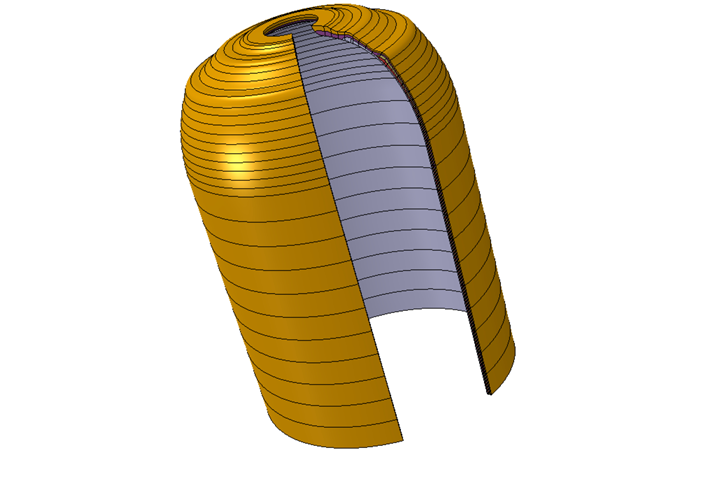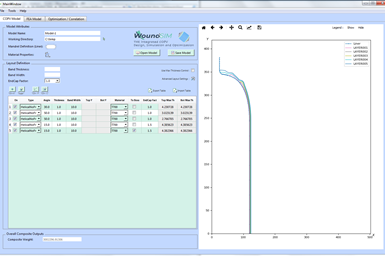WoundSIM software tool simplifies design and simulation of composite pressure vessels
Rapid and efficient tank design process is achieved via an integrated FEA software translator, advanced parametric optimization, simulation and load case testing and post-processing capabilities.

COPV tank model. Photo Credit, all images: S Vertical, QustomApps
WoundSIM is a new software tool targeting the design, simulation and optimization of composite-overwrapped pressure vessels (COPVs). While it is primarily used in the automotive and aerospace industries, it has gained usage with the U.S. Navy, various research centers, the education sector and for hydrogen storage as a rapid and efficient tank design process. It is developed, supported and maintained by Dassault Systèmes (Vélizy-Villacoublay, France) Simulia development partners QustomApps (Ponder, Texas, U.S.) and S Vertical (Châtenay-Malabry, France). The first beta version was released in 2019, with additional features to be included in 2022.
Under WoundSIM, a graphical interface is used to instantaneously view the composite layup as the table of composite layers is defined. Layer thickness buildup is automatically calculated, along with the varying wind angles. Smeared material properties are also computed and assigned throughout the COPV, and an integrated finite element analysis (FEA) software translator enables users to generate a run-ready FEA model to assess the thermal and mechanical responses of the COPV.
Principle WoundSIM features noted include:
- Enhanced layer thickness buildup for better correlation against geometry of produced tanks;
- Comprehensive design parameters enabling a quick variation of layer shape;
- A comprehensive, standalone user interface;
- GUI short time response (<1 sec/30 layers);
- Smart layup rendering for easy layer selection and identification;
- Rapid, fully automated tank FE model generation and post-processing;
- Full compatibility with Dassault Systèmes’ Simulia Abaqus Unified FEA;
- Automated Abaqus WCM models conversion;
- Compatibility with Simulia Isight for advanced parametric optimization;
- Public XML API to ensure compatibility with other winding software or customer’s in-house tools and formulations;
- Integrated tank parametric optimization capabilities to reduce tank weight;
- And integrated models VS tests calibration.
After the layup definition and visualization in the WoundSIM interface, users can generate the reservoir geometry and the corresponding FEA models in order to perform all needed simulations. Generated models include tank layer geometry and enhanced reservoir mesh generation; transformed material properties; automated assembly with other reservoir components; loads and boundary condition definitions; and the possibility to generate 2D, 3D, shell and solid models. Abaqus/CAE models can also be edited and enriched by the user.

WoundSIM graphical user interface (GUI).
All required load cases to design the tank can be run on the generated FE models, including static/dynamic burst pressure, heat transfer analysis, coupled temperature displacement, dynamic drop tests and impacts and cyclic and fatigue assessment. Fail stress and fail strain parameters can also be included in the FE analysis for a realistic prediction of composites layers failure.
Moreover, the WoundSIM-to-Abaqus interface provides a number of seamless post-processing capabilities such as specialized path plotting and contour plotting tools for quick tank response assessment. WoundSIM includes a compiled user subroutine library that gives access to all composite-specific output post-processing quantities such us winding angles, fiber matrix stresses and strains and damage parameters.
Finally, WoundSIM offers advanced engineering capabilities and integrated algorithms that allow several capabilities for composite reservoir designers and simulation engineers. Some capabilities involve parametric design, Design of Experiment, batch computing, reservoir geometry variability study, correlation to other winding software, models correlation with produced reservoirs and reservoirs images processing.
View this link for more information on WoundSIM.
Related Content
3D-printed CFRP tools for serial production of composite landing flaps
GKN Aerospace Munich and CEAD develop printed tooling with short and continuous fiber that reduces cost and increases sustainability for composites production.
Read MoreComposite sidewall cover expands options for fire-safe rail components
R&D project by CG Rail explores use of carbon fiber-reinforced thermoplastics and recycled manufacturing scrap to meet fire safety, weight and volume targets.
Read MoreAurora reveals latest SPRINT X-Plane design concept
An Aurora and Boeing team advances its high-speed, vertical lift concept to the preliminary design phase, which features three lift fans, a more refined composite exterior and an uncrewed cockpit.
Read MoreASCEND program update: Designing next-gen, high-rate auto and aerospace composites
GKN Aerospace, McLaren Automotive and U.K.-based partners share goals and progress aiming at high-rate, Industry 4.0-enabled, sustainable materials and processes.
Read MoreRead Next
All-recycled, needle-punched nonwoven CFRP slashes carbon footprint of Formula 2 seat
Dallara and Tenowo collaborate to produce a race-ready Formula 2 seat using recycled carbon fiber, reducing CO2 emissions by 97.5% compared to virgin materials.
Read More“Structured air” TPS safeguards composite structures
Powered by an 85% air/15% pure polyimide aerogel, Blueshift’s novel material system protects structures during transient thermal events from -200°C to beyond 2400°C for rockets, battery boxes and more.
Read MoreDeveloping bonded composite repair for ships, offshore units
Bureau Veritas and industry partners issue guidelines and pave the way for certification via StrengthBond Offshore project.
Read More










.jpg;maxWidth=300;quality=90)












